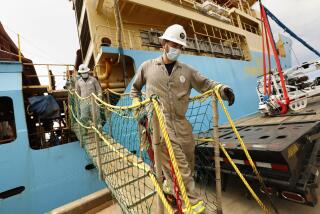The Deep : Firm Gets Tiny Sub Shipshape for Research in the Pacific
- Share via
Before a passenger squeezes into his tiny sub, Richard Slater explains that the 15-foot-long yellow submarine carries enough oxygen for two people to spend three days on the bottom of the ocean.
One of his assistants reassuringly adds that the two-person submersible has logged more than 2,700 deep-sea dives since 1983 and has never been forced to draw from its emergency air supply.
Last year, Slater’s Oxnard-based company took researchers on more than 500 dives, running both sides of the U.S. coastline on missions ranging from biological research to geological surveys.
On Friday, Slater and his seven-man crew were busy preparing the sub, called Delta, and its mother ship, the Jolly Roger, for the annual research season, which begins today when they leave for a 10-day cruise to Alaska.
For Slater, his business partner and sub designer Doug Privitt and crew, the next five months of their lives belong to the scientists who rent their submarine and research vessel for about $6,000 a day.
The Jolly Roger will ply the waters off the Pacific coastline, stopping periodically so the Delta can pick up scientists and dive everywhere from Alaska to Monterey and points between.
“I have to admit, it’s not a bad job,” Slater said as crew members raise the submarine off the Jolly Roger with a large, hydraulic crane.
“I like scuba-diving, but it doesn’t compare to this,” said Slater, who holds the unofficial world record for having logged more than 2,000 dives in submersibles as a pilot and a researcher.
“We get so much deeper, we see things no one else gets to see,” Slater said. “And the thing is, you can stay down all day and you don’t get wet or cold.”
Actually, the inside of the Delta is a bit moist, though it does offer evidence of Privitt’s underwater artistry as a high-tech submarine designer.
The submersible is an underwater research station, a dry environment designed to enable scientists to observe the oceanic depths while taking notes, movies and photographs. The two-man crew can even take samples of the environment outside, with the help of mechanical arm and scoop.
During a demonstration dive, assistant pilot Chris Ijames explains how the space-age technology works. The fathometer checks for depth, the sonar detector is triggered by movement around the submarine, separate compartments in the bow and aft fill with water to cause the sub to sink.
And then there’s the decidedly low-tech roll of paper towels to wipe off the water condensation from Plexiglas windows. “The whole thing tends to condensate in here,” Ijames says, pressing a lever to flood the ballast chambers.
Then the sub suddenly begins to sink, dropping to the harbor bottom 25 feet below. A message crackles on the Delta’s underwater communications radio that links it to the Jolly Roger. “What do you see down there?” Slater jokingly asks.
“Green murky water and kicked up mud,” Ijames responds in kind.
The first official dives of the research season will begin with demonstrations for local and Washington-based scientists near Anacapa Island today, Slater said.
Researchers from the National Oceanographic and Atmospheric Administration in Washington want to see exactly what the sub can do. After all, the federal agency has funded much of the research performed on the sub over the years.
Others--from UC Santa Barbara marine biologists to researchers with the state Department of Fish and Game--are anxious to learn if the underwater workhorse could be used on projects in the area.
“The Delta is kind of considered the Jeep of our industry. It’s hard-working, small and gets around good,” Slater said. “Unfortunately, if you look at all the places we dive, you’ll see that Southern California is not among the regular sites.”
Last year the Delta made 553 dives. They included a stint with marine biologists studying king crabs in Alaska, another with geologists researching gas seeps off the Oregon coast, a round of dives with fisheries experts in Washington state and a series of dives in the Monterey submarine canyon to collect sea creatures for the Monterey Bay Aquarium.
“People say to me, ‘You’ve made 2,000 dives, you must be getting bored,’ ” Slater said. When asked, he can weave yarns of Alaskan halibut as big as the Delta and Costa Rican sea bass with eyes the size of its portholes.
“I tell them every dive is exciting,” submersible designer Privitt said. A noted submarine designer for more than 30 years, Privitt has more than 800 dives in the Delta and other submersibles he has built in his Torrance machine shop.
Among their most challenging projects, the partners list diving in the Santa Barbara Channel in the aftermath of the 1969 oil spill and diving through Prince William Sound in Alaska after the 1989 Valdez catastrophe.
As troubling as events such as those were to environmentalists, Slater said there is a certain amount of paranoia in their doomsday prophesies about the seven seas. “The deep ocean is basically pristine, but no one ever wants to say it,” he said. “They don’t know, because they don’t get out there and see it like we do.”






